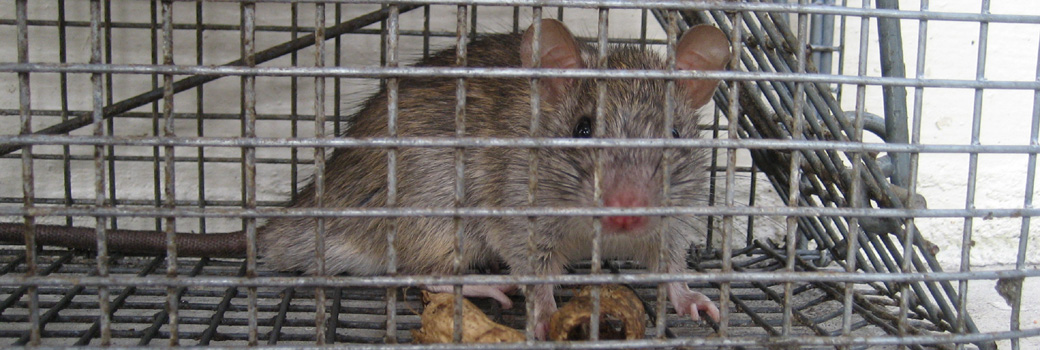- Chicago Educational Article of the Month - Chicago Rat Removal - Information About Rats
Chicago Rat Removal - Information About Rats
About Rats
A rat belongs to the family of rodents and looks similar to a mouse. Rats are characterized by their sparsely haired tail and their long pointed snout. Below are some basic facts about rats.
Appearance
Rats tend to share similar physical characteristics as that of other rodents. They have two large incisors that never stop growing throughout the rat’s lifetime. Because of their large teeth, rats are almost always gnawing on something. This is a major disadvantage for anyone who has a rat infestation in their home. A rat’s body is covered in fur that is less dense on its ears and tail. Although they move around on their four legs, they are capable of standing on their hind legs.
The tail length, color, size and the texture of the fur varies among different rat species. A simple example is how a Norway rat is large and fat while roof rats tend to be longer and slender. Also, a roof rat has a tail that is typically longer than the rest of its body. Some rats have blunt faces, while others have pointy protruding snouts.

Life cycle
Rats reach sexual maturity at 3 or 4 months and can live up to two years. Once a female rat is impregnated, the gestation period is anywhere between 20-22 days. Baby rats are weaned off their mother’s milk after 28 days. In their two year life expectancy, a female rat can breed up to 6 times. The average litter for a rat is 7. Rats do not have any specific breeding time.
Habitat
Rats can either live in trees or on the ground. Scientifically, it has been shown that one rat that prefers a specific habitat can still adapt to live in any other. The Norway rat and the roof rat are the most commonly known rat species. The Norway rat is terrestrial while the roof rat is arboreal.
Chicago Norway rats tend to burrow their way into things. They are most likely to be found on the outside walls of homes and in large clumps of bushes or other vegetation. You are likely to find these kinds of rats underneath patios or sidewalks.
Chicago Roof rats prefer being off the ground. They can easily be found in palm, yucca and cypress trees. They also prefer elevated parts of a house. These rats can be found in rafters, attics and roofs. Chicago rat removal gets them out of the attic.
Behavior
The behavior of rats depends on the size of the population. If the population is big, larger rats will assert themselves over the smaller ones and make themselves more dominant. Also, males will not see the need of protecting a female burrow. If a female is in heat, several dominant males will mate with her depending on who’s got better social standing.
Rats also tend to be aggressive whenever they are threatened and are known to bite, chase off or even box whoever is threatening them. Belly-up postures are also often seen in rats who are threatened.
Rats thrive really well in human developments and are hence considered a nuisance. Rats are resilient as they can travel over long distances. Rats are also very skeptical about foreign objects and it is for this reason that it is especially hard for a human to catch a rat.
Diet
Rats aren’t choosy when it comes to their diet. They are capable of eating everything and anything. Human homes tend to provide rats with a wide variety of menu choices, making it that much harder to get rid of them. Some rat species are drawn towards certain food types. For instance, Norway rats tend to prefer food that is rich in protein like meat. Roof rats are drawn more to fruits, and are subsequently attracted to places that have numerous fruit trees. Rats are resourceful and can get their food from dust bins, pet food bowls, and some even tend to eat their own dead.
Rat Borne Diseases
Rat scratches and bites can result in fever and disease. Rat urine is responsible for the spread of leptospirosis which causes liver and kidney failure in humans. The most famous and dangerous rat borne disease was the bubonic plague, also known as the Black Plague. This disease was transmitted when fleas from rats would bite humans. This disease alone was responsible for the death of millions during the Middle Ages. Rats are also known to cause allergens in humans as well.
Predators of Rats
In most human settlements, the main enemy of the rat is a human. Because of the destruction of property that rats cause as well as the numerous diseases they carry, rats are frequently exterminated by humans. Cats are also known predators of rats.
In the outdoors, rats fall prey to hawks, owls and falcons who popularly feed on rats. Some snakes have rats as a part of their diet too. The best predator may be us, of Chicago rat removal!
To learn more about our services, visit the Chicago wildlife removal home page.

